#Outcome-Driven Development
Explore tagged Tumblr posts
Text
Beyond Agile: Discover 10 Alternative and Effective Approaches for Product Development
While Agile is a widely successful and adaptable methodology, some alternative approaches or complementary strategies may be more effective depending on the context of the product, team dynamics, and business goals. Here are a few methods that can be considered more effective or tailored for specific scenarios than Agile: 1. Lean Development Overview: Lean focuses on reducing waste, improving…
#Agile alternatives#Business Agility#Design Thinking#DevOps#Dual-Track Agile#Feature-Driven Development#innovation in product management#Kanban#Lean development#Outcome-Driven Development#product development strategies#Product-Led Growth#safe#software development methodologies#XP
0 notes
Text
From Chaos to Clarity: How Impact Mapping Drives Real Results
In today’s fast-moving world of product development, teams often struggle to connect their work with real business value. Impact Mapping drives real results by aligning efforts with strategic goals, ensuring teams focus on what truly matters rather than just delivering features. What is Impact Mapping and Why Does It Matter? Impact Mapping is a strategic planning technique that helps…
#agile#business goals#business impact#Collaboration#focus#Impact Mapping#lean startup#OKRs#outcome-driven#product development#product management#roadmap planning#software development#strategy
0 notes
Text
The political origin of financial market dislocations: How an amusement park developer’s illiquidity turned into a credit market crisis
This column uses the recent credit crunch in South Korea as a natural experiment that demonstrates how political gaffes and decision errors can cause severe financial market dislocations. It reveals how a single, politically motivated default of negligible size turned into a financial system-wide credit crisis requiring a massive government intervention to remedy. [...] The evidence suggests that the default was not related to the prevailing economic conditions, hence the causality ran from the default to the observed outcomes that followed.
On 28 September 2022, Gangwon province’s newly elected conservative governor, Kim Jin-tae, unexpectedly declared that he would not honour the local government’s guarantee on the A1-rated (the highest rating) asset-backed commercial paper (ABCP) of Gangwon Jungdo Development Corp (GJC), the developer of the Legoland Korea amusement park located in the same province. There was no indication prior to the announcement or since then that the local government was under financial pressure: the missed payment was not due to budgetary reasons. It is understood that the new governor refused to make the payment due to political/ideological considerations as Legoland Korea was associated with the previous liberal governor (Nam 2022, Park 2022). Indeed, the 205 billion won (around $144 million) that was owed by GJC was a minor item for the local government and it was not being asked to pay back the entire amount (Park 2022). GJC missed the payment on 29 September and the default was declared on its asset-backed commercial paper on 5 October.
The credit markets started pricing in the implication of the GJC default, an unthinkable event that signalled to market participants that even a government guarantee does not provide adequate protection after all. The incident led to a reassessment of credit risk in broader markets over subsequent days.
The increase in the borrowing costs did not abate even after Gangwon province vowed to pay back the entire debt on 21 October to respond to mounting criticism (the debt was fully paid on 12 December). The about-face of Gangwon province three weeks after the decision to renege on its promise bolsters the fact that the initial decision was political, not driven by financial pressure on the province.
[...] Countries find innovative ways to shoot themselves in the foot. These range from inane monetary policy in Turkey (Gürkaynak et al. 2022), to inane fiscal policy in the UK, to inane refusals to honour a small loan guarantee in Korea. The last one sounds much less consequential than the first two, but it turned out to have major systemic effects. The Korean episode was not one of multiple equilibria where the minor default acted as a focal point; it was an episode where the financial market participants learned that previously unthinkable refusals to honour loan guarantees by local governments were possible, which changed the risk perception for the entire financial system. As this case study shows, even minor political shocks can snowball into an avalanche in times of elevated uncertainty and policymakers need to be mindful of this source of risk.
204 notes
·
View notes
Text
Aspects of the Sun in the Natal Chart

☌ Sun Conjunct Other Planets
Conjunctions can be both positive and negative. On the positive side, they combine the energies of the planets involved, enhancing their qualities and creating a powerful synergy. This can result in heightened strengths and abilities in the areas governed by the conjunct planets. On the negative side, conjunctions can amplify challenging traits, potentially leading to imbalances or conflicts if the combined energies are not well-integrated or harmonized.
Sun Conjunct Moon: This aspect blends the conscious self (Sun) with the emotional self (Moon), creating a strong inner harmony. It can result in a well-integrated personality, where feelings and actions are aligned. However, it can also lead to a lack of objectivity, as emotions heavily influence one's sense of identity and decision-making processes. Sun Conjunct Mercury: This conjunction enhances mental agility and communication skills. The individual's thoughts and expressions are closely tied to their identity, making them articulate and persuasive. However, it can also result in overthinking or a tendency to be overly self-involved in conversations and ideas. Sun Conjunct Venus: This aspect brings charm, creativity, and a strong sense of aesthetics. The individual values beauty and harmony, and often possesses artistic talents. It enhances social skills and the capacity for love. On the downside, there may be a tendency towards vanity or indulgence in pleasures. Sun Conjunct Mars: This conjunction fuels ambition, courage, and assertiveness. The person is energetic and driven, often excelling in leadership roles. However, it can also lead to impulsiveness, aggression, or a domineering attitude if not tempered with self-control. Sun Conjunct Jupiter: This aspect bestows optimism, generosity, and a broad outlook on life. The individual is likely to be enthusiastic and confident, often pursuing knowledge and growth. However, there can be a tendency towards overexpansion, arrogance, or taking excessive risks. Sun Conjunct Saturn: This conjunction imbues the personality with discipline, responsibility, and a strong work ethic. The individual is practical and reliable, often achieving success through perseverance. On the downside, it can lead to excessive seriousness, rigidity, or feelings of inadequacy. Sun Conjunct Uranus: This aspect promotes originality, independence, and a desire for freedom. The individual is innovative and often ahead of their time, valuing uniqueness. However, it can also result in unpredictability, rebelliousness, or difficulty conforming to social norms. Sun Conjunct Neptune: This conjunction enhances creativity, intuition, and spiritual awareness. The person is often idealistic and compassionate, with a rich inner life. However, there can be challenges with escapism, confusion, or a tendency to live in a fantasy world. Sun Conjunct Pluto: This aspect endows the individual with intensity, power, and transformative abilities. They are driven and often undergo significant personal evolution. However, it can also lead to a controlling nature, obsession, or power struggles if not managed constructively.
⚹ Sun Sextile Other Planets
Sextiles are positive aspects that encourage cooperation and the easy flow of energies between the involved planets. This harmonious connection facilitates smooth interactions and enhances the beneficial qualities of each planet, leading to supportive and constructive outcomes. The ease of this aspect promotes opportunities for growth, creativity, and positive developments in the areas influenced by the sextile.
Sun Sextile Moon: This harmonious aspect balances the conscious and emotional selves, promoting inner peace and emotional stability. It enhances intuitive understanding and facilitates cooperative relationships, as the individual can easily connect with others on an emotional level. Sun Sextile Mercury: This aspect facilitates clear communication and quick thinking. The person is intellectually agile and enjoys learning, making them adept at problem-solving and conveying ideas. It supports writing, teaching, and any field requiring articulate expression. Sun Sextile Venus: This aspect fosters charm, sociability, and a love of beauty. The individual has a natural talent for art, diplomacy, and maintaining harmonious relationships. It enhances attractiveness and social grace, making it easier to form positive connections with others. Sun Sextile Mars: This aspect enhances vitality, assertiveness, and initiative. The individual is confident and proactive, capable of taking decisive action to achieve their goals. It supports physical activity and sports, as well as leadership roles where energy and drive are needed. Sun Sextile Jupiter: This aspect brings optimism, generosity, and a sense of adventure. The person is likely to be fortunate and expansive, with a positive outlook on life. It supports growth, travel, education, and any pursuit that broadens horizons and brings personal fulfillment. Sun Sextile Saturn: This aspect blends creativity with practicality, enhancing reliability and perseverance. The individual is disciplined and goal-oriented, capable of steady progress and achievement. It supports long-term planning and the ability to handle responsibilities effectively. Sun Sextile Uranus: This aspect promotes innovation, independence, and a forward-thinking attitude. The person is open to change and new experiences, often embracing unconventional ideas. It supports technological skills, inventive projects, and the ability to adapt to evolving circumstances. Sun Sextile Neptune: This aspect enhances creativity, compassion, and spiritual insight. The individual is intuitive and empathetic, often drawn to artistic or humanitarian pursuits. It supports imaginative projects, healing practices, and the ability to connect with others on a deep level. Sun Sextile Pluto: This aspect brings depth, power, and transformative potential. The person has strong willpower and the ability to effect change in their life and environment. It supports personal growth, investigative work, and any endeavor requiring resilience and determination.
□ Sun Square Other Planets
Squares are negative aspects that create tension and challenges between the involved planets, prompting growth through conflict. This dynamic aspect often leads to struggles and obstacles that need to be overcome, pushing individuals to address and resolve the underlying issues. The friction generated by squares can be difficult to navigate, but it ultimately encourages personal development and resilience as one learns to balance and harmonize the conflicting energies.
Sun Square Moon: This challenging aspect creates tension between the conscious self and emotions. The individual may struggle with inner conflicts, leading to inconsistency or mood swings. However, it can also drive personal growth as they work to reconcile these opposing forces. Sun Square Mercury: This aspect can lead to difficulties in communication and decision-making. The person may experience mental restlessness or find it hard to articulate their thoughts clearly. However, it also stimulates intellectual development and problem-solving skills through challenges. Sun Square Venus: This aspect can create conflicts between personal desires and social harmony. The individual may struggle with self-worth or experience difficulties in relationships. However, it also drives the pursuit of balance and personal values, fostering growth in these areas. Sun Square Mars: This aspect can lead to impulsiveness, aggression, and conflicts. The person may struggle with balancing assertiveness and cooperation. However, it also fuels ambition and drive, pushing the individual to overcome obstacles and assert their will. Sun Square Jupiter: This aspect can lead to overconfidence, excess, and risk-taking. The individual may struggle with moderation and practicality. However, it also promotes growth and learning through experience, encouraging the person to refine their judgment and expand their horizons. Sun Square Saturn: This aspect creates tension between personal expression and responsibility. The individual may struggle with self-doubt, restrictions, or authority issues. However, it also fosters resilience and discipline, driving them to achieve success through hard work and perseverance. Sun Square Uranus: This aspect can lead to unpredictability, rebelliousness, and conflicts with authority. The person may struggle with balancing individuality and societal expectations. However, it also promotes innovation and personal freedom, encouraging them to break free from limitations. Sun Square Neptune: This aspect can create confusion, idealism, and escapism. The individual may struggle with clarity and practical matters. However, it also fosters creativity and compassion, pushing them to develop a realistic approach to their dreams and ideals. Sun Square Pluto: This aspect can lead to power struggles, intensity, and transformation. The person may experience internal conflicts and a need for control. However, it also drives profound personal growth and empowerment, encouraging them to harness their inner strength.
△ Sun Trine Other Planets
Trines are positive aspects that create a smooth and beneficial connection between the involved planets, enhancing talents and creating a sense of ease. This harmonious aspect facilitates the natural flow of energy, making it easier to express and develop the qualities associated with the planets. Trines often lead to emotional balance, inner harmony, and an overall sense of well-being, as the supportive nature of this aspect encourages the effortless integration of strengths and abilities.
Sun Trine Moon: This harmonious aspect fosters inner balance and emotional well-being. The individual enjoys a natural flow between their conscious intentions and emotional needs, promoting self-acceptance and stable relationships. It enhances intuition and empathy. Sun Trine Mercury: This aspect facilitates clear thinking, effective communication, and intellectual growth. The person is articulate and mentally agile, often excelling in academic or communicative pursuits. It supports learning, teaching, and any field requiring mental acuity. Sun Trine Venus: This aspect brings charm, grace, and a love of beauty. The individual enjoys harmonious relationships and has a natural talent for art and diplomacy. It enhances social skills and attractiveness, making it easy to form and maintain positive connections. Sun Trine Mars: This aspect enhances vitality, confidence, and assertiveness. The person is proactive and decisive, often excelling in leadership roles. It supports physical activities, sports, and any endeavor requiring energy and drive, promoting successful outcomes. Sun Trine Jupiter: This aspect bestows optimism, generosity, and a broad perspective. The individual is fortunate and expansive, often pursuing growth and learning. It supports travel, education, and any pursuit that broadens horizons and brings personal fulfillment. Sun Trine Saturn: This aspect blends creativity with discipline, promoting reliability and perseverance. The person is practical and goal-oriented, capable of steady progress and achievement. It supports long-term planning and the ability to handle responsibilities effectively. Sun Trine Uranus: This aspect promotes innovation, independence, and a forward-thinking attitude. The individual embraces change and new experiences, often thriving in unconventional settings. It supports technological skills, inventive projects, and adaptability. Sun Trine Neptune: This aspect enhances creativity, compassion, and spiritual insight. The person is intuitive and empathetic, often drawn to artistic or humanitarian pursuits. It supports imaginative projects, healing practices, and deep connections with others. Sun Trine Pluto: This aspect brings depth, power, and transformative potential. The individual has strong willpower and the ability to effect change in their life and environment. It supports personal growth, investigative work, and resilience in overcoming challenges.
☍ Sun Opposition Other Planets
Oppositions in astrology create a challenging dynamic by polarizing the energies between the planets involved. This aspect typically leads to tension, conflicts, and a heightened awareness of opposing forces within oneself or in relationships. Opposites often attract, but they also necessitate finding a balance between extremes. While oppositions can be disruptive, they also offer opportunities for growth, as they compel individuals to reconcile conflicting energies and integrate opposing viewpoints for greater personal understanding and harmony.
Sun Opposite Moon: This aspect creates tension between the conscious self and emotions, often manifesting in conflicts between personal desires and relationships. The individual may struggle with mood swings or inner conflicts but can also develop a deeper understanding of themselves through these challenges. Sun Opposite Mercury: This aspect can lead to miscommunication and mental tension. The person may struggle with expressing themselves clearly or balancing rational thought with personal identity. However, it also stimulates intellectual growth and self-awareness. Sun Opposite Venus: This aspect creates conflicts between personal desires and relationships. The individual may struggle with self-worth or experience difficulties in love and social interactions. However, it also fosters growth in understanding and balancing personal and relational needs. Sun Opposite Mars: This aspect can lead to conflicts, impulsiveness, and challenges in asserting oneself. The person may experience internal struggles or external confrontations but can also develop greater self-control and assertiveness through these experiences. Sun Opposite Jupiter: This aspect can lead to overconfidence, excess, and risk-taking. The individual may struggle with moderation and practicality but can also learn valuable lessons in balance and wisdom through their experiences. Sun Opposite Saturn: This aspect creates tension between personal expression and responsibility. The person may struggle with restrictions, self-doubt, or authority issues but can also develop resilience and discipline through these challenges. Sun Opposite Uranus: This aspect can lead to unpredictability, rebelliousness, and conflicts with authority. The individual may struggle with balancing individuality and societal expectations but can also develop innovative solutions and personal freedom. Sun Opposite Neptune: This aspect can create confusion, idealism, and escapism. The person may struggle with clarity and practical matters but can also develop a deeper understanding of their dreams and ideals through overcoming these challenges. Sun Opposite Pluto: This aspect can lead to power struggles, intensity, and transformation. The individual may experience internal conflicts and a need for control but can also undergo profound personal growth and empowerment through these experiences.
©️kleopatra45
#astrology community#astroblr#astrology#astrology readings#astrology tumblr#astro notes#astrology observations#houses in astrology#zodiac#astrology aspects
846 notes
·
View notes
Text
Writing Notes: Action Story

Great action writing draws in your audience, getting their adrenaline pumping as they turn the page.
Elements of a Good Action Story
There are many elements that come together to form a good action story and allow you to tell your own story in your own perfect way:
Sentence length. Writing action scenes involves knowing how to pace the narrative so that readers are fed the action at a steady and satisfying speed. If your action sequences are built with long-winded sentences full of verbs and descriptions, it will likely confuse and overwhelm your audience. Shorter sentences get to the point more simply, delivering the visual quickly and efficiently, cutting down on bulky filler words.
Active voice. Keeping the narrative voice active keeps up the momentum of your story. Readers see how the main characters are actively working and reacting in their environment in what feels like real time, packing more punch into the syntax and keeping the narrative lively.
Character goals. Action should occur for a reason—characters’ actions should be based on their motivations, their points of view, and their previous choices. A protagonist’s actions should always propel them towards their main goal in a way that is related to the plot events at hand. A character’s goals affect their character development, forcing them to change and evolve depending on the way events unfold in your story.
Consequences. Action can be fun to see unfold, but without the element of danger or a potentially disastrous outcome, it lacks that exciting element that keeps audiences on the edges of their seats. Action writing should make the audience feel like something could happen to the hero at any moment, without being overwhelmed with events and losing their place in the narrative.
Tips for Writing Effective Action Scenes
Show cause and effect. From the first time your character receives their call to action, follow up activity with the consequences of their decision. Sometimes the character is causing the action to occur, and other times they’re reeling from action that just occurred. Moments can also be built up so that the cause of certain effects or the effects themselves aren’t realized in their entirety until much later.
Create visuals. Use action in a concise, impactful manner in order to deliver strong images for the audience. The clearer your scenes are, the more easily the audience can understand and absorb them. You don’t want readers or viewers to be hung up on seemingly impossible details or sequences that don’t flow. Visuals that get right to the point and can be quickly understood are best for conveying action.
Drive the story forward. In a great story, the moments in between where the action is happening should still feel alive and like the story is always progressing. Even if your hero isn’t facing off against the villain just yet, the scenes without action should still be driven by the character’s goals—readers or viewers may become disinterested by a sudden slump in energy and stagnancy to the writing. Use montage, flashbacks, or other story writing techniques to keep up the pace while delivering necessary narrative information.
Keep action moments short. Action-adventure stories have many moments of high-intensity activity, and it’s best that they happen in short spurts so that the reader does not get exhausted with high-octane events. The battle against the rogue android in your science fiction action story shouldn’t be one scene that’s 50 pages long—the readers need a breather once in a while in order to reset the intensity and have it built back up for them all over again.
Use effective language. When you write a fight scene or a chase scene, the action is moving quickly, so your language should too. Short sentences packed with powerful images that move at a logical pace are useful in conveying strong action sequences that are easy to visualize. A character should bolt to their destination, not just run. Specific diction can make all the difference in how the action of your story is perceived and how your story is experienced overall.
Source ⚜ More: Notes & References ⚜ Writing Resources PDFs
#action#writeblr#literature#writers on tumblr#writing reference#dark academia#spilled ink#writing prompt#creative writing#writing tips#writing advice#light academia#writing inspiration#writing ideas#jan matejko#writing resources
178 notes
·
View notes
Text
How to Master Motivation


Hi friends,
Today I want to talk about motivation and finding ways to maintain it in our daily lives. Motivation is a crucial factor that drives us to achieve our goals, overcome challenges, and stay committed to our development.
Understand the locus of control
Our locus of control, internal or external, is the degree to which we believe we have control over what happens to us in our lives. It influences how we respond to circumstances that impact us and how motivated we feel to take action.
An external locus of control is when we believe that our life and the outcomes we experience are a result of external forces beyond our power. We think everything that happens to us occurs because of chance or luck—two things we can’t control.
The key to staying motivated is to develop an internal locus of control. This is when we believe that we’re responsible for the things happening to us and understand that we have control over the outcome. It’s a level of self-determination where we realize our efforts, decisions, and habits create the life we live.
So, how do we adopt an internal locus of control?
The first point I want to emphasize is that, regardless of your perception of how much control you have over your life, the amount of work you put into something is always within your control. The first step is to abandon the mindset that everything is left up to chance and, because of this, you should stop trying. You need to understand that you always have some level of power over your circumstances, even if you’ve been told otherwise:
Be more aware of the choices you make and realize there is always a choice to be made.
Don’t be afraid to ask for help or guidance from those around you.
Spend time self-reflecting and trying to understand yourself better. Reflect on previous instances where you’ve felt a lack of control and write down what could have been done instead.
Don’t be afraid to fail; it’s an opportunity to learn.
Know the different types of motivation
Next, I want to talk about the different types of motivation and how they impact you.
There are 4 different types of motivation, each with their own distinctions:
Intrinsic motivation: This is where you do something because it aligns with your values or just because it’s fun. Although it’s good to have intrinsic motivation, this type is fragile and can be undermined when we start feeling like we’re losing autonomy over our choices.
Extrinsic motivation: This is what most people think of when they imagine motivation. It’s when our motivation comes from outside of us—we’re doing something for a reward or to avoid a punishment. It’s the opposite type of motivation that you should seek if you want to be self-driven.
Introjected: This type of motivation can create resentment or tension. We do something because if we don’t, we’ll feel shameful or guilty. For example, you might go to the gym not because you enjoy it or care about the health benefits, but because you feel guilty if you don’t work out.
Identified: The reason you’re doing something is because it aligns with your idealized self. It’s something that you’ve internalized to be important and allows you to behave in accordance with your self-concept and identity. This is the most important type because it creates habitual behaviors are no longer choices. We understand our identity and that certain habits and behaviors need to be done so that we’re constantly aligned with our higher selves. For example, you might regularly volunteer at a local shelter or organization because you’re someone who values compassion and community service.
So, how can we implement identified motivation more into our lives?
Really try and understand the reasoning behind a goal you want to achieve. Ask yourself “why do you actually want this thing?”. This is also a good time to review your values and whether or not your goal aligns with them.
Constantly remind yourself about why the outcome matters to you because we often forget the reason that we started in the first place. —ex.
Like James Clear said, make your goal, system, habit, or whatever you’re wanting to accomplish more motivating or fun. Beyond that, start associating the reward with the challenge itself. If you’re training for a marathon, instead of seeing the finish line as the only reward, find or fulfillment in the training process and the discipline you developed along the way.
Adopt a positive mindset. Rather than complaining about having to workout in the morning or studying for an exam, start saying “I get to study for this exam and further my education” or “I’m blessed to have a body that works for me and allows me to exercise”. It’s all about perspective and embracing gratitude. If you put half the energy that you use from complaining into figuring out how to take the next step, you’ll accomplish a lot more.
Don’t neglect your emotional and mental health
Slumps are very real, and mental health can impact every aspect of motivation. Self-improvement and changing your life aren’t easy journeys by any means, and there will be times when stress and feelings of being overwhelmed can paralyze you. In these moments, it’s critical to take a break, a breather, or anything that can help reset your mental health. Remember to engage in activities that support your emotional needs. Not every second of the day needs to be spent doing something productive or working toward your goals. It’s okay to take breaks and have rest days; in fact, I think it’s crucial.
Reward yourself often, even for the smallest achievements. It’s not about what you completed, but the fact that you completed something at all. Spend time acknowledging your accomplishments.
Take it one step at a time and remember no action is too small. Starting small is what helps us build consistency in the long run.
Embrace positive self-talk. Avoid talking yourself into a negative spiral, as it will only make you lose motivation and put you in a slump.
Get an accountability partner. Having someone in your corner who will cheer for you and keep you accountable is a game changer.
Stay motivated, stay grateful, stay resilient.
Love,
Luna<3
#self concept#Identity#self development#goal setting#self discipline#self improvement#self care era#self care#self love#glow up#positive mindset#positive thoughts#mental growth#mental health#that girl#good habits#itgirl#leveling up#habits#productivity#aesthetic#clean girl#self reflecting
493 notes
·
View notes
Text
A comprehensive new review by experts in the sustainability science field, published in The Lancet Planetary Health, is challenging the long-held assumption that economic growth is necessary for societal progress.
The review, led by the Institute of Environmental Science and Technology of the Universitat Autònoma de Barcelona (ICTA-UAB) and titled "Post-growth: the science of wellbeing within planetary boundaries," explores the rapidly advancing field of post-growth research and presents a compelling case for prioritizing human well-being and ecological sustainability over endless economic expansion.
[...]
Key findings from the review include: The Limits to Growth: The review revisits the findings of the 1972 report "Limits to Growth," noting that the world is currently tracking the "Double Resources" scenario, where collapse is driven by pollution rather than resource scarcity. This aligns with current concerns about climate change and biodiversity loss. Decoupling is Insufficient: While relative decoupling of GDP from resource use is common, the review finds no evidence of sustained absolute and sufficient decoupling, and models suggest that it is unlikely even with optimistic assumptions about technology. Social Limits to Growth: The review finds that above a certain level of income, economic growth does not improve human well-being, and the costs of growth (e.g., pollution and social upheaval) may offset its benefits. There are diminishing returns for social outcomes such as health, education, and poverty reduction as GDP increases. Post-Growth Policies: The review highlights the development of ecological macroeconomic models that test policies for managing without growth. It discusses a range of policies to reduce growth dependencies and promote well-being, including universal basic services, working-time reductions, job guarantees, and carbon and wealth taxes. Well-being within Limits: The review emphasizes that high levels of well-being can be achieved at lower levels of resource use. It argues that focusing on public services, income equality, and democratic quality can meet human needs with much lower energy use. North-South Dynamics: The review acknowledges the unequal exchange between the Global North and the Global South, where richer countries appropriate resources and labor from poorer nations. It suggests that post-growth in high-income countries might benefit low-income countries by reducing this exploitation. However, the review notes that post-growth could also negatively affect low-income countries that are dependent on exports to high-income countries, unless low-income countries implement policy interventions towards monetary sovereignty, industrial policy and effective delinking from high-income economies.
17 January 2025
190 notes
·
View notes
Text
youtube
Putting aside my issues with Neil Gaiman as a person, I genuinely enjoyed the Sandman universe. I also recognize that many people contributed to crafting the story beyond just Gaiman himself. So, let's begin with an acknowledgment of some of the complexities and imperfections involved. Namely Gaiman is POS. I said what I said. The following contains spoilers for both the Sandman comics and the Netflix adaptation. If you haven’t read the source material or watched the show and wish to remain unspoiled, stop reading here. For me, the Netflix adaptation has been a strong homage to the source material—except for one aspect: the relationship between The Second Corinthian and Johanna Constantine. Now, we can talk about how the show has retconned and effectively erased the Corinthian's sexuality. Any form of erasure—especially when it involves marginalized groups—is deeply problematic, and queer erasure in particular deserves to be addressed. In fact we will discuss it at length, so buckle up. Some people argue that retconning The Corinthian’s sexuality is acceptable because he’s still portrayed as bisexual—so, technically, still queer. However, retconning a gay character to be bisexual—particularly to facilitate a heteronormative presenting relationship—is problematic. It actually contributes to bisexual erasure. So if you're thinking that making The Corinthian bisexual means increased representation for bisexual people, it's worth reconsidering what it really means to retcon a marginalized character’s established sexual orientation. Changes like this often don’t add representation—they dilute it. It can also imply that a character’s same-gender attraction was just a “phase” or that they were “confused” before ultimately settling into a heterosexual relationship. This perpetuates harmful stereotypes and undermines both gay and bisexual identities, rather than affirming them.
Rewriting a previously gay character into a heterosexual presenting relationship can reinforce the notion that straight relationships are the default or the “correct” outcome for characters, which subtly upholds heteronormative standards and undermines queer representation. These are my initial thoughts on how Netflix handled the dynamic between these two characters. Ultimately, it feels like a misguided attempt at representation—well-intentioned perhaps, but still reinforcing harmful stereotypes. Another issue worth addressing is the overall uninspired writing—specifically, the use of the overdone “I just met you and now I’m in love with you” trope. It weakens character development and makes the relationship feel unearned and superficial. This is more of a small critique than a harsh judgment, but with complex characters like The Corinthian and Johanna Constantine, it feels somewhat unfair—and not very true to their identities—to pair them romantically just because they happen to share a single episode of screen time. Media’s tendency to romanticize opposite-sex characters simply to create tension or advance the plot is lazy writing because it relies on an easily digestible formula. It’s also harmful, as it implies that platonic intimacy is less valuable than romantic love, reinforces stereotypes that men are primarily driven by sexual desire, and suggests that women’s identities are largely defined by their relationships with men. Moreover, it undermines the idea that genuine platonic friendships between men and women can exist.
What’s unfortunate about the Johanna Constantine and The Corinthian storyline is that if Matthew hadn’t been such an expensive CGI character, they might not have felt the need to use Johanna to fill that role. This entire storyline—and the relationship at its center—was manufactured out of production necessity, not out of genuine care for the characters or a commitment to good storytelling. One final issue I’d like to address is how the handling of their story also reinforces the idea that heteronormative relationships are “good” or preferable, while LGBTQ relationships are implicitly portrayed as less valid or undesirable. And it sustains this notion that villains are often times queer coded. In the first season, the First Corinthian’s primary sexual attractions and interactions are toward men, and he is portrayed as a villainous serial killer. By the second season, however, he’s transformed into a kind, almost “boy scout” figure—the perfect babysitter—with his main relationship being heteronormative. In the first season, Johanna is a morally ambiguous character who ran away from her girlfriend and left behind a dangerous magical item. While Rachel’s fate isn’t entirely Johanna’s fault, it results in a sad, preventable tragedy. By the second season, Johanna is out in the world doing good deeds, like finding lost babies, and once again, her primary relationship is heteronormative. So, on one hand, you have the Corinthian, whose queerness in the first season is framed as predatory, and on the other, Johanna, whose queerness is tied to a tragic, guilt-laden relationship. But when the two are placed in a heteronormative-presenting situationship in season two, it’s portrayed as sweet, romantic, and uncomplicated—and that contrast is, frankly, a bit problematic. Especially considering how complex these characters are—and how richly layered they were in the first season, regardless of their circumstances—it feels reductive to simplify them through a neatly packaged, heteronormative dynamic. Their queerness was previously tied to complexity, pain, or danger, while their straight-presenting connection is framed as safe, redemptive, and uncomplicated. That contrast isn’t just disappointing—it reinforces troubling patterns in how media handles queer representation. So when I see fan content that leans heavily into heteronormative interpretations of these characters, I do place some of the blame on the show. For many viewers, the Netflix adaptation is their primary entry point into the Sandman universe, and the way these dynamics are portrayed on screen shapes how audiences perceive and recreate them. When adaptations of the source material leans into certain dynamics—especially ones that simplify or rewrite complex, queer characters into more palatable, heteronormative molds—it inevitably influences how fans engage with those characters. Fanworks often reflect what the show emphasizes, and when a show sidelines queerness or reframes it as tragic, dangerous, or disposable, it sends a message, even unintentionally, about what kinds of relationships are “worthy” of attention, romance, and emotional investment.
This isn’t just about shipping preferences; it’s about representation and narrative weight. When queer relationships are consistently framed as flawed or doomed, and straight-presenting ones are celebrated and normalized, it reinforces harmful cultural patterns. And for newer audiences—who may not have read the comics or seen the broader nuance of these characters—the show becomes the default canon. That’s where media responsibility matters. tl;dr I am not a fan of the prefabricated nonsense that was The Second Corinthian and Johanna Constantine. This storyline is really the only thing I can truly say did not vibe with me at all on any level.
#the sandman s2#the corinthian#johanna constantine#lgbtq#representation#bad tropes#stereotypes#Youtube
64 notes
·
View notes
Note
Is your Saint based on your oc (i think) Shou? If thats how they're named

So they are decently unrelated, but I must admit I am a fan of mysterious characters who keep their eyes closed all the time.
Shou's whole deal is that they're a Sherlock-type level of perceptive and clever in addition to having extremely keen foresight, constantly seeing seconds to minutes into the future, with the capacity to sort through all those threads of fate to find the one that will give them the desired outcome. Their apparent cheerful and absent-minded demeanor is something of a cover to a very cunning, cutthroat, and ruthlessly driven personality. They can be arrogant, but they are so good at what they do that their arrogance is never unfounded.
Saint on the other hand has a much more calm and aloof demeanor that is reflective of how they are most times, but they can quickly become neurotic, especially once when things don't go the way they expect. Countless lifetimes spent repeating the same actions and interacting with the same people has given them a very keen sense of navigating very familiar situations, but they can be obsessive about making sure everything turns out just so. Compared to Shou, Saint is incredibly inflexible and significantly less in-control of any given situation.
Any similarity between the two is pretty much only aesthetic. Though, funny enough, my friend and I like to joke about this little club we have with some of our characters:
He has a character, a fox who's unwillingly immortal, incapable of dying, and has lived so long and recognizes patterns so easily that he might as well have futuresight. Despite the circumstances, he's very happy and very kind.
Saint is doomed to repeat the same lifetime forever, effectively making them immortal within a very limited scope. They somehow have less success than my friend's character in reliably reproducing patterns. Classic Sisyphus type behavior.
Shou eventually comes to have a problem where their future sight grows beyond their control. They end up living entire lifetimes within visions, growing old and finding happiness or ruin only to return to the present, losing everything they thought they'd built in an instant, repeatedly, unable to tell when reality ends and the next lifetime vision begins. They get burnt out hard, unwilling to invest themselves in anything at risk of having the rug pulled out from under them again.
Together all these characters make up a very niche club of animal people who are damned by supernatural, existential circumstance to be effectively immortal, and also always have their eyes closed.
Fun fact, Saint and Shou are also both nonbinary transfems (Saint is agender, and I'm not sure what Shou has going on). They also both speak Yongasabi. The barest basis for Yongasabi was derived from the worldbuilding project that Shou is from, then developed and completed in the context of Rain World. Now that Yongasabi is a complete language, I've also returned it to its original context and given it to Shou.
123 notes
·
View notes
Text
ISTG if I have to spend the next two years watching people be pre-emptively miserable over Hellyna for no reason other than the general audience being dumb and therefore that must somehow mean Dan is just going to throw his whole story out of the window...
I understand plenty of shows have done that in the past but, no offense, it's usually pretty shitty shows with shitty writers. Prestige television almost never does that unless its showrunners are dudebros who have Game of Thrones as their template for what they think great television is. If you are a good writer you don't pander to people who don't understand your work, or change direction willy nilly based on what people expect or don't expect. If anything, you double down on it to really drill it into people's heads. And while I can't say I trust ANY writer 100%, Dan doesn't give me the vibe of someone who's ego-driven and who either wants to outsmart or over-pander to his audience.
Plus, nothing whatsoever seems to hint at them suddenly deciding that because people don't like/understand Helena she's going to be written off at "the villain" and that's it. Every single time any of them talks about Helena the theme is consistently about how trapped she is, how Helly is a manifestation of her repressed nature, and Britt has been avoiding any question about Helena's "redemption" like the plague, which means it's a spoiler. And sidelining her would literally go against the entire premise of the show being about people finding their true selves through their innie-outie dynamic, about outies recognising that the innies are people, and about whether kinship transcends across innies and outies. It's also why any scenarios where Helly refuses reintegration because "Helena bad" is so off putting to me. Because that is Helly literally learning NOTHING and being stuck where she was in S1. She has literally reached the point in the finale to start accepting she IS Helena, and you think that's all going to be for nothing? Or that Cobel's in-your-face line about SHE IS AN EAGAN YOU MEAN NOTHING TO HER is going to prove true?? There's nothing more delicious to a writer than subverting their own characters' expectations and preconceived notion of other characters as a conduit to subvert the audience's.
I know I myself speculated about Helena "killing herself" for Helly by permanently severing herself, but that was early on in my Severance adventure and before I really got a good grasp of the underlying message the show is aiming for. I don't completely rule it out, but I think it's a very unlikely outcome at this point and even if something along those lines were to happen, it will happen after Helena has had plenty of development and "natural reintegration" with Helly so that there will be a lot of Helena in Helly by the time all's said and done. They're not going to suddenly go "well oops! Helena is evil and must die so Helly and/or Markgemma can ride off into the sunset".
83 notes
·
View notes
Text
Good News - May 15-21
Like these weekly compilations? Support me on Ko-fi! Also, if you tip me on Ko-fi, at the end of the month I'll send you a link to all of the articles I found but didn't use each week - almost double the content!
1. Translocation of 2,000 rhinos in Africa gets underway in “one of the most audacious conservation efforts of modern times”

“The 2,000 rhinos - more than are currently found in any single wild location in Africa - represent around 12-15% of the continent’s remaining white rhino population. […] “Rhinos perform an important ecological function in the environment as a large grazing herbivore,” says Dale Wepener[….] “The protection of rhino is far more than just looking after rhino; other species that occur in the protected areas will benefit from the protection,” explains Jooste. “This will lead to an increase in diversity and result in much healthier ecosystems.”
2. Florida Corridor Buffers Effects of Climate Change on Wildlife — And People

“A massive multi-partner effort that has conserved 10 million acres for wildlife in Florida over past decades will help buffer wildlife—and people—from the effects of climate change, a new report says. […] Protecting these corridors is important for wildlife genetics, demography and connectivity […], conducting prescribed fires in the corridor can reduce the risk of more intense wildfires [… and] they can provide buffers against hurricanes and seasonal thunderstorms.”
3. Global life expectancy to increase by nearly 5 years by 2050 despite geopolitical, metabolic, and environmental threats
“Increases are expected to be largest in countries where life expectancy is lower, contributing to a convergence of increased life expectancy across geographies. The trend is largely driven by public health measures that have prevented and improved survival rates from cardiovascular diseases, COVID-19, and a range of communicable, maternal, neonatal, and nutritional diseases (CMNNs).”
4. Valencia has Spain’s longest urban park

“Jardin del Turia (Turia Garden) is the green spine of the City of Valencia and Spain’s (and possibly Europe’s) longest urban park stretching for a length of 8.5 kilometres [… and] the current administration plans to make Jardin del Turia Europe’s largest city green space by extending it to the sea[….] Almost all Valencia residents (97 per cent) live within 300 metres of an urban green space. […] Jardin del Turia is a true urban oasis that provides exceptional thermal comfort, with a temperature difference of up to three degrees compared to other areas of the city.”
5. This Paint Could Clean Both Itself and the Air
“When an artificial ultraviolet light source shines on [photocatalytic] paint, the nanoparticles react with pollutants to make them break down—theoretically removing them from the nearby air and preventing a discoloring buildup. [… R]esearchers developed a new photocatalytic paint that they claim works using UV rays from ordinary sunlight, making its self-cleaning properties easier to activate. They’ve also shown that they can effectively produce this paint from recycled materials [including fallen leaves].”
6. Planting Seedlings for a Cooler Rockingham
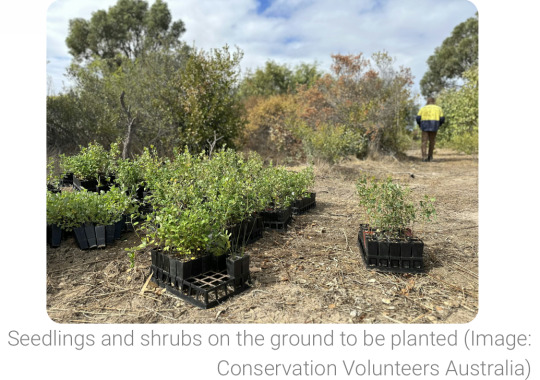
“A dedicated group of volunteers recently planted over a thousand native seedlings in Lewington Reserve [… and] re-established canopy cover to areas of the reserve to create cooling shade for the local community and provide homes for native wildlife. […] Planting lots of trees and shrubs in urban areas can help create shade and cool cities, mitigating the impacts of climate change, contributing to biodiversity conservation and building greener, more resilient communities.”
7. Sydney’s first dedicated affordable housing for trans women designed to deliver ‘positive outcomes’

“Community housing provider and charity Common Equity NSW, […] which is for people on very low to moderate incomes, prides itself on creating inclusive living and promotes the independence and well-being of people and communities […, and] will deliver the first-of-its-kind social housing in a bid to provide a safe place to live for transgender women seeking an affordable home.”
8. Rewilding: How a herd of bison reintroduced to Romania is helping ‘supercharge’ carbon removal

“170 European Bison reintroduced to Romania’s Țarcu mountains could help capture and store the carbon released by up to 84,000 average US petrol cars each year. […] By grazing a 48 square kilometre area of grassland in a wider landscape of 300 kilometres squared, they helped to capture an additional 54,000 tonnes of carbon each year. That is around 10 times the amount that would be captured by the ecosystem without the bison.”
9. World’s biggest grids could be powered by renewables, with little or no storage

“[…] 100% renewable supply can then match the load by putting surplus electricity into two kinds of distributed storage worth that [an energy expert] says are worth buying anyway – ice-storage air-conditioning and smart bidirectional charging of electric cars, and recover that energy when needed, filling the last gaps with unobtrusively flexible demand.”
10. Supporting the Long-Term Survival of Copper River Salmon and Alaska Native Traditions

“With $4.3 million in NOAA funds, the Copper River Watershed Project and The Eyak Corporation will remove fish passage barriers, opening more streams for salmon spawning and subsistence fishing. [… As part of this effort, o]ld narrow culverts that constrict water flow will be replaced with “stream simulation” culverts wide enough to fit the full stream, including its banks. They are also deep to allow contractors to place stones and other material inside to mimic a natural stream bottom.”
May 8-14 news here | (all credit for images and written material can be found at the source linked; I don’t claim credit for anything but curating.)
#hopepunk#good news#rhino#white rhino#africa#conservation#rewilding#climate change#florida#wildlife#life expectancy#health#spain#green space#urban parks#recycling#trees#global warming#trans#affordable housing#australia#bison#romania#carbon#carbon capture#renewableenergy#reforestation#salmon#alaska native#nature
393 notes
·
View notes
Text
The Inconspicuous Writing Gem: Daeran’s Look-alike Contest Breakdown

The Dance of Masks brought the long-anticipated last hurrah to the Knight Commander’s story. Although it was announced that the DLC would focus on the companions, I wasn’t holding my breath for substantial content that would actually enrich the characters’ plots. The game is already massive and has a ton of variables, so expecting the writers to continue storylines that can have multiple outcomes would be unreasonable. But one scene far exceeded my expectations and set the bar high for the rest of the expansion, rendering me more critical about some of its elements than I would normally be. The event in question may not appear as much, but the true artistry in writing stories driven by the player’s choice fully reveals itself in what we don’t see on the surface. Daeran’s look-alike contest varies greatly, depending on how his personal quest was resolved, and, therefore, serves as a semi-epilogue to his arc. I wanted to post an analysis of his character’s progression for quite some time, and this send-off is a fitting opportunity to delve into this matter. I’ll break down the differences in the new scene as well as in a few others and share my overall thoughts on what this addition brings to the table. Brace yourself because it’s going to be long.
I'll start with a quick reminder of what Daeran’s questline outcomes are, because I'm going to reference them a lot:
Good, in which he’s openly grateful to the Knight Commander despite having to face the tribunal, and Liotr, noticing their bond, intervenes so the Inquisition doesn't lock him up;
Lobotomy, in which Daeran reluctantly accepts his predicament of having to face the trial, Liotr doesn't support him and after the crusade, the Count is sent to the asylum and lobotomized;
HappyEvil, in which the Commander kills Liotr to secure Daeran’s freedom;
ArchEvil, in which Daeran doesn't have any trust in the Commander, feels deserted and murders Liotr to avoid the trial.
At first glance, there's nothing profound about Daeran’s festival quest — it fits his image to indulge in the vain act of self-celebration by choosing the most accurate imitation of himself. However, this simple setup proves itself clever when we realize that, by observing the contestants, he sees himself in a distorting mirror. Coincidentally, each participant appears to represent a different facet of the Count’s character. Therefore, his reactions to them speak volumes of the self-image and mindset he developed during the crusade in each scenario.
Among the doubles, we have an aasimar who mimics Daeran's arrogance and cruelty, and constantly interrupts other participants' speeches with mocking remarks.
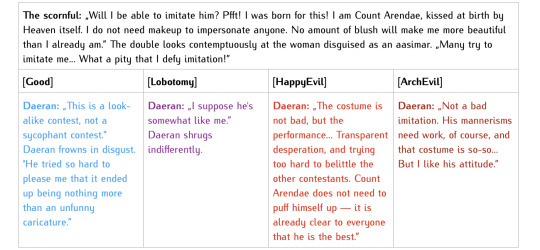
A woman who recreates Daeran's sophisticated bon vivant persona.

A drunkard who paints Daeran as a worthless and utterly unapologetic rake.

And finally, an innocent boy who keeps staring at Daeran with admiration and portrays him as a virtuous hero of the crusade.

After the presentation of the contestants is over, Daeran asks the Commander’s opinion. Again, his responses to their verdict vary in each case (unless they choose the cat), but the difference in how he reacts to being compared to the little boy is the most telling.
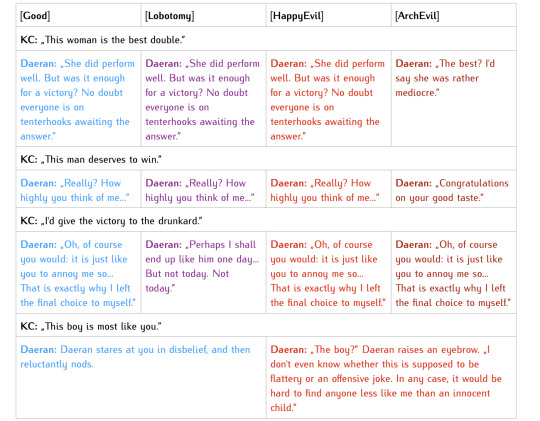
No matter what the protagonist suggests, the winner of the contest is fixed for each of the outcomes. If the Commander failed to earn Daeran's trust and he murdered Liotr himself, the conceited aasimar is declared the winner.

If the Commander killed Liotr, the Count awards the lady.

If the quest was resolved peacefully (either Good or Lobotomy), Daeran chooses the boy and has a heartwarming exchange with him.

This variety of possible scenarios and the way they are handled encapsulate why I consider Daeran's story so intricately woven and enjoyable to analyze. He's an incredibly flexible and dynamic character whose potential endings range from becoming a saint to a homicidal maniac. But what makes this duality and everything that comes in between so engaging is that all these vastly contradictory conclusions are equally organic and convincing, given his rich characterization and the player’s choices. The subtle yet significant divergences in the narrative paths maintain the integrity of his personality and prevent his evolution from seeming far-fetched while efficiently showcasing his growth or regression.
Regretfully, this attention to detail is missing from the other new scenes, which don't convey a similar sense of progression and can come off as somewhat disconnected from the rest of the playthrough. The rendezvous, for example, avoids references to how the player concluded Daeran's romance and quest. Given these plotlines' non-linearity, it's an understandable approach, but it prevents the scene from exploring deeper themes and hitting more emotional notes. What's particularly detrimental to the its overall intensity is the absence of exclusive dialogue for the True Love outcome. Ironically, it's the two worst endings that get unique and surprisingly heartfelt lines.
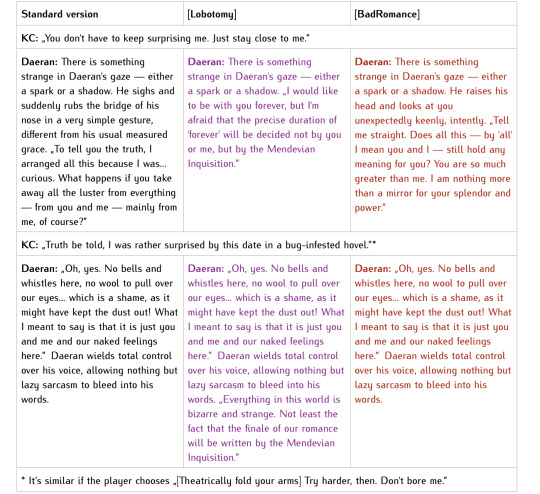
The difference is insignificant, however, because the conversation always plays out the same. All in all, the segment is nice and leaves a lot to the imagination, but only partially exploits its potential. Meanwhile, the festival mini-quest embraces the aforementioned strengths of the storyline's writing, giving every iteration of Daeran distinct dialogues that clearly demonstrate the impact the crusade and acquaintance with the Commander had on him.
I won't examine every dialogue branch in detail but will mainly focus on the Good scenario. As someone who likes this ending the best and even advocates the controversial writing in the final confrontation with Liotr, I always thought the narrative failed to properly sell its implied benefits. Apart from the closing conversation in the quest itself, late-game provides little reactivity to differentiate the outcomes, making it hard for the players to fully grasp the internal shift that Daeran undergoes. Comparison of said dialogue in various scenarios reveals his perspective in Good route as the least egocentric and overall most mature. Unfortunately, in an individual playthrough, these qualities can get overshadowed by the Count's dissatisfaction with the inconveniences he will eventually have to endure.

Aside from that, the effects of each resolution manifest only in Daeran's responses to one question in the romantic route and how he expressed his feelings regarding Galfrey’s death.
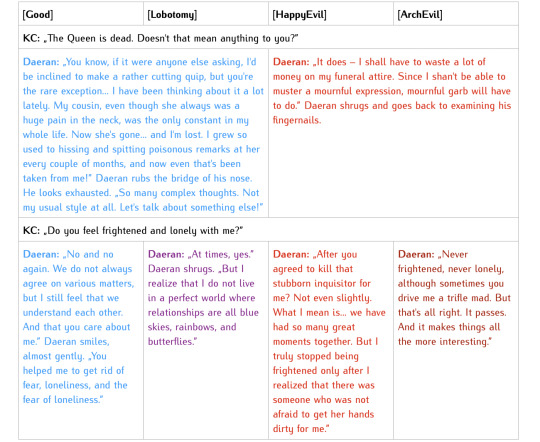
Even though they show evident contrast and serve as a much-needed emotional pay-off for the moral dilemma the player faced in the storyline finale, both are relatively minor, with the Queen one completely missable in most playthroughs. When combined with the similar omission of negative repercussions for Daeran’s moral condition and emotional maturity in other outcomes, it's not surprising many players believe he doesn’t ever change or that becoming better fundamentally clashes with his nature.
The discussed competition scene remedies the narrative’s deficiencies, ultimately proving this statement untrue. In the Good outcome, Daeran presents a reasonable dose of self-distance. When confronted with the drunk’s insults, he replies with humor and courtesy, which is a stark contrast to his reactions in the Evil outcomes and his past responses to criticism. Despite being hurt by the harsh judgment, he understands such a low opinion of himself is somewhat justified. The Count's mild response and his sensitivity to the suggestion that he's nothing more than an unfeeling scoundrel may even indicate that he has developed some remorse for his past actions. He also dismisses unwarranted flattery and distances himself from the brash egotism. All without falling into a spiral of gloom and self-deprecation that occurs in the Lobotomy scenario. Introspectiveness and vulnerability showcased here are a seamless continuation of the self-evaluation Daeran does in the High Trust version of his quest upon being supposedly betrayed by the Commander.
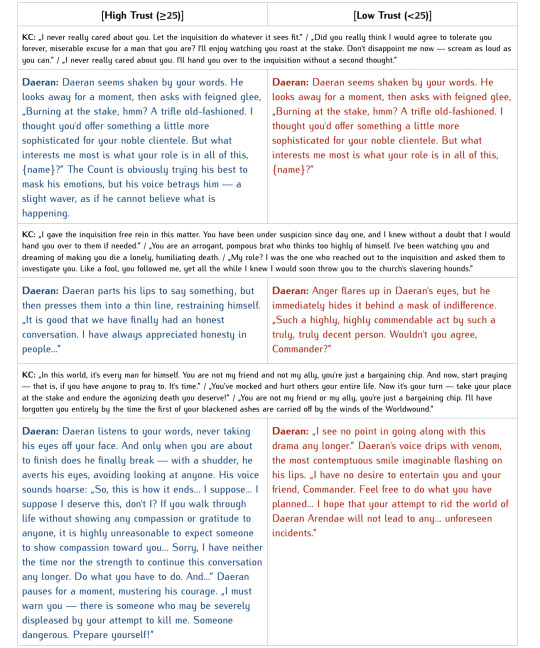
It's all the more unfortunate that the other interactions in the DLC don’t acknowledge these differences and instead return to the common denominator of all endings. As a result, the player will go from Daeran, who self-reflects and claims the aasimar presents an unfunny caricature of him, to Daeran in the tavern, who puffs himself up exactly like the guy (using even the same words) and seeks more sycophantic praise. While it's expected for him to put on an airy act and tease others, the absolute lack of self-awareness he previously exhibits in the Good route is quite jarring. Considering the complexity of the storyline as well as all sorts of limitations, such inconsistencies are inevitable (the base game already has a fair share of them) and in the end, one can easily reconcile them through their own interpretations. However, after being spoiled by a reactivity treat like the festival mini-quest, it's disappointing that the remaining dialogues lack similar nuance.
In the Good scenario, Daeran's behavior reinforces what we learn in the epilogue — that in this version, he has the most difficulty navigating through his newfound freedom and redefining himself in it. Choosing the winner of a silly contest shouldn't be hard for him, and it isn't in the Evil outcomes. There, the self-satisfied Count (who in both cases already has the blood of at least one innocent man on his hands) picks what he perceives as an idealized version of himself — be it the aestheticized depiction of his self-centredness or the unbridled and unyielding haughtiness. Noteworthily, in the Happy variant, Daeran openly flirts with the lady and, in both Evil paths, if not romanced, attempts to seduce his favored contestant. It’s peak narcissism, given the implications of the scene. In the peaceful outcomes, especially the Good one, the ordeal is a series of unpleasant self-reflections that even causes him to become overwhelmed by sorrow at one point. In the end, Daeran’s choice stems not from an ulterior motive or a desire to boost his ego but from genuine fondness for the boy. The youngster's belief in the Count’s kindness and heroism reminds him of his own innocence that was prematurely and brutally snatched from him. At his core, Daeran is not a self-sufficient master of his own fate but a helpless child thrown by unfortunate circumstances into otherworldly oppression and a vicious cycle of selfishness. In the Evil routes, he successfully deludes himself into believing he’s the former, but here, he realizes he’s the latter.
We're used to seeing Daeran scoffing at saccharine narratives and lofty ideals, and in the Evil versions, he's indeed annoyed with the boy’s portrayal of him. In one of them, he even anticipates him to be disenchanted, finding the prospect amusing. In the campaign's early stages, the Count voices his dissatisfaction with being enrolled in the crusade and laments the tarnishing of his ill reputation. Any suggestions that he may be secretly vulnerable are met with biting retorts. But now, Daeran doesn't disabuse the child and isn’t even bothered by being seen as a heroic figure. There also isn’t any objection when the Commander points out the similarity between him and the boy. He’s shocked they can see through him but decides to be honest and agrees with their assessment. Daeran’s sensitivity and his tendency to be more emotionally transparent with the protagonist is, at this point, a recurring theme in the peaceful outcomes, so it’s a shame that when they later choose to compliment his vulnerable soul, he's always equally dismissive.
Daeran is perfectly aware of how damaging cruel disillusionment can be to one’s psyche. As a child, he witnessed firsthand the powerlessness of good in the face of evil, the suffering adhering to moral principles can bring, and how those who claim to be righteous can turn out to be as callous and uncaring as hardened villains. These experiences left the young Count with a pessimistic view of the world and human nature, making him adopt coping mechanisms that only deepened his melancholy and loneliness. Knowing this, he wishes to spare the boy a similar fate and plays along to preserve his innocence.
In the non-peaceful outcomes, Daeran gives the signet away as if it was an insignificant bauble. But even though we barely ever see this side of him, some dialogues indicate he’s proud of his heritage and his ancestors' role in Mendev’s history. They were valiant defenders of the kingdom, who, for generations, protected its borders from any threat. This is who the Count, as a scion of the Arendae house, was originally destined to be and who, it so happens, the boy sees in him. Perhaps his take on him makes Daeran reflect on how differently things could have turned out had it not been for his family's demise and the Other’s interference. It undoubtedly revokes memories of his roots and deceased kin, since he not only rewards the child with the ring but also educates him on its meaning and sentimental value, expressing unexpected sincerity and kindness. In the Lobotomy scenario, this gesture is particularly bittersweet — with his impeding childless death, Daeran’s lineage is going to expire, making the memento the only way to keep its memory alive.
Finally, the Good version of the scene carries a deep symbolic significance. Daeran rewards one person who doesn't focus on his superficial traits or recreates the mask he hides behind. The image the boy paints of him may not be accurate, but while the other portrayals embody what the Count turned into under the Other's influence, this one shows what he could have been if he hadn’t lost the childish naivety he now longs for. And who he, despite his own skepticism, still can or perhaps even already started to become, thanks to the good protagonist's compassion and support. Just like the Commander, the boy views him as someone better than what his predicament forced him to be. And Daeran, confronted with sincere faith in him, cannot help but answer the call.
#pathfinder: wrath of the righteous#pathfinder wotr#pwotr#wotr#wrath of the righteous#owlcat games#daeran arendae#daeran#Дейран#my analysis
302 notes
·
View notes
Text
A lawsuit filed Wednesday against Meta argues that US law requires the company to let people use unofficial add-ons to gain more control over their social feeds.
It’s the latest in a series of disputes in which the company has tussled with researchers and developers over tools that give users extra privacy options or that collect research data. It could clear the way for researchers to release add-ons that aid research into how the algorithms on social platforms affect their users, and it could give people more control over the algorithms that shape their lives.
The suit was filed by the Knight First Amendment Institute at Columbia University on behalf of researcher Ethan Zuckerman, an associate professor at the University of Massachusetts—Amherst. It attempts to take a federal law that has generally shielded social networks and use it as a tool forcing transparency.
Section 230 of the Communications Decency Act is best known for allowing social media companies to evade legal liability for content on their platforms. Zuckerman’s suit argues that one of its subsections gives users the right to control how they access the internet, and the tools they use to do so.
“Section 230 (c) (2) (b) is quite explicit about libraries, parents, and others having the ability to control obscene or other unwanted content on the internet,” says Zuckerman. “I actually think that anticipates having control over a social network like Facebook, having this ability to sort of say, ‘We want to be able to opt out of the algorithm.’”
Zuckerman’s suit is aimed at preventing Facebook from blocking a new browser extension for Facebook that he is working on called Unfollow Everything 2.0. It would allow users to easily “unfollow” friends, groups, and pages on the service, meaning that updates from them no longer appear in the user’s newsfeed.
Zuckerman says that this would provide users the power to tune or effectively disable Facebook’s engagement-driven feed. Users can technically do this without the tool, but only by unfollowing each friend, group, and page individually.
There’s good reason to think Meta might make changes to Facebook to block Zuckerman’s tool after it is released. He says he won’t launch it without a ruling on his suit. In 2020, the company argued that the browser Friendly, which had let users search and reorder their Facebook news feeds as well as block ads and trackers, violated its terms of service and the Computer Fraud and Abuse Act. In 2021, Meta permanently banned Louis Barclay, a British developer who had created a tool called Unfollow Everything, which Zuckerman’s add-on is named after.
“I still remember the feeling of unfollowing everything for the first time. It was near-miraculous. I had lost nothing, since I could still see my favorite friends and groups by going to them directly,” Barclay wrote for Slate at the time. “But I had gained a staggering amount of control. I was no longer tempted to scroll down an infinite feed of content. The time I spent on Facebook decreased dramatically.”
The same year, Meta kicked off from its platform some New York University researchers who had created a tool that monitored the political ads people saw on Facebook. Zuckerman is adding a feature to Unfollow Everything 2.0 that allows people to donate data from their use of the tool to his research project. He hopes to use the data to investigate whether users of his add-on who cleanse their feeds end up, like Barclay, using Facebook less.
Sophia Cope, staff attorney at the Electronic Frontier Foundation, a digital rights group, says that the core parts of Section 230 related to platforms’ liability for content posted by users have been clarified through potentially thousands of cases. But few have specifically dealt with the part of the law Zuckerman’s suit seeks to leverage.
“There isn’t that much case law on that section of the law, so it will be interesting to see how a judge breaks it down,” says Cope. Zuckerman is a member of the EFF’s board of advisers.
John Morris, a principal at the Internet Society, a nonprofit that promotes open development of the internet, says that, to his knowledge, Zuckerman’s strategy “hasn’t been used before, in terms of using Section 230 to grant affirmative rights to users,” noting that a judge would likely take that claim seriously.
Meta has previously suggested that allowing add-ons that modify how people use its services raises security and privacy concerns. But Daphne Keller, director of the Program on Platform Regulation at Stanford's Cyber Policy Center, says that Zuckerman’s tool may be able to fairly push back on such an accusation.“The main problem with tools that give users more control over content moderation on existing platforms often has to do with privacy,” she says. “But if all this does is unfollow specified accounts, I would not expect that problem to arise here."
Even if a tool like Unfollow Everything 2.0 didn’t compromise users’ privacy, Meta might still be able to argue that it violates the company’s terms of service, as it did in Barclay’s case.
“Given Meta’s history, I could see why he would want a preemptive judgment,” says Cope. “He’d be immunized against any civil claim brought against him by Meta.”
And though Zuckerman says he would not be surprised if it takes years for his case to wind its way through the courts, he believes it’s important. “This feels like a particularly compelling case to do at a moment where people are really concerned about the power of algorithms,” he says.
370 notes
·
View notes
Text
my executive function model
I've heard the term "executive dysfunction" thrown quite a lot online, but I couldn't really pinpoint what exactly it means. I decided I first need to understand what executive function is first in order to make sense of it.
After some research (not a lot so take it with a big grain of salt) and self-reflection I developed an executive function model to better understand where I struggle and where I excel.
I identified 8 executive functions, split into primary and secondary, and defined how they interact with each other.
I created a diagram that illustrates and summarizes this model, kind of a tldr. The information from the diagram is described in the text in this post though. At the end of the post is an example of how this model applies to me specificaly.

core executive functions
Those I kept the same as in the research I did, as they seem to be more widely agreed upon.
Inhibitory control - suppressing inappropriate behavior, resisting distractions and urges, emotional control
Working memory - holding, recalling, and manipulating information, mental juggling
Cognitive flexibility - switching tasks, shifting attention, tolerating change, letting go of stuck thoughts
secondary executive functions
Those are more adjusted to fit my personal experience, and are in the sequence it which I personaly engage in activities.
Strategic analysis - understanding the problem, reasoning, generating solutions, predicting outcomes; you need to analyze the problem and generate what can be done about it
Decision-making - balancing risk, reward, and long-term outcomes, deciding on course of action; you need to then compare and decide on one of the courses of action from the generated ones
Planning and organization - planning, organizing, breaking tasks into steps, time estimation, prioritizing; once you know what you want to do, you have to plan the actual actionable steps of it, place when you will do them, in what sequence
Action initiation - getting started on tasks, overcoming inertia, avoiding procrastination; you actually need to follow through the plan, go and do the thing you planned
Self-monitoring - monitoring progress, noticing when you're off-task or overwhelmed, error detection, adjusting behavior, self-assessment; once doing the thing, you need to monitor yourself on how you're doing on the task but also notice if something else hasn't become more important
how they interact
The primary executive functions support the secondary, they are like building blocks of them:
1. Inhibitory control
Strategic analysis: prevents rushing to conclusions; allows pause and reflection before jumping to solutions
Decision-making: suppresses impulsive or emotionally-driven choices; supports delay of gratification
Planning and organization: helps avoid distractions when building plans and ignore irrelevant details
Action initiation: inhibits avoidance behaviors or urges to delay ("I’ll do it later")
Self-monitoring: suppresses defensive reactions to noticing errors; allows recalibration
2. Working memory
Strategic analysis: holds problem details, relevant knowledge, and potential solutions in mental space
Decision-making: maintains multiple options, their pros/cons, and predicted outcomes to compare
Planning and organization: tracks task steps, sequences, and dependencies during mental planning.
Action initiation: remembers what the task is and how to begin — even after delays or distractions
Self-monitoring: holds the original goal or plan in mind while checking current performance against it.
3. Cognitive flexibility
Strategic analysis: allows consideration of alternative problem framings or novel solutions
Decision-making: enables reevaluation of options and openness to changing course
Planning and organization: helps adjust plans dynamically if priorities shift or obstacles arise
Action initiation: Supports shifting mental state from rest to task-engaged mode
Self-monitoring: helps switch strategies mid-task, revise expectations, or tolerate outcomes that don’t go as expected
my personal application
Firstly, out of the three core executive functions my weakest one is working memory. I am quite good at the other two though.
Going off that profile of my primary executive functions, I perform as below in the secondary executive functions:
Strategic analysis - I excel at it. My high cognitive flexibility allows me to see a lot of options, and inhibition allows me to focus on analysing a problem for a long time. I compensate for my low working memory by writing things down, visualizing them etc.
Decision-making - I am rather bad at it. After I analyse the problem to its smallest components and generate lots of ideas in the first step, there are a lot of details to keep in mind when comparing them, and this is where my poor working memory struggles. I also have problems with confidence in my decisions, since I can so clearly see so many options possible and their consequences after my analysis.
Planning and organization - another area I am good at, because I can write things down or draw them out thus compensating for my bad working memory. Inhibition allows me to be realistic with my plan, and cognitive flexibility allows me to adapt it to the actual needs.
Action initiation - a real bottleneck in my process. At this stage I usually have so many details I can be easily overwhelmend with my poor working memory. Also it involves deciding to do the thing, and we already know I struggle with decisions. My high inhibition may also cause a lot of hesitation here.
Self-monitoring - I am moderately good at it. I can struggle with keeping the original goal of the task in mind because of poor working memory, but can manage if it's cleary defined and written down. High congnitive flexibility allows me to adjust my actions according to the performance, and inhibition allows me to avoid distractions and reflect without becoming emotional.
As you can see from this picture, I clearly can benefit the most from using various visual aids and allowing myself to "think on paper" rather than forcing myself to hold everything in my brain. I just seem to have small RAM, but my processor is quite strong.
#schcomtalk#executive function#executive dysfunction#actually autistic#neurodivergent#neurodiversity#autism
74 notes
·
View notes
Text
Sabbath - strategic intelligence
Wooin Yoo, Hyuk Kwon, Joker, Vinny Hong
I originally did this with Sabbath and my oc but have to post this w/o her, since I don't post about my ocs.
Wooin Yoo:

Preemptive strategist: planning ahead, anticipating possible outcomes, prefers structure and clear plans, excellent at long-term goals and risk management, can often stay calm or rational in chaotic situations, can foresee the consequences of the actions. might struggle to adapt to suddenly new situations, slower when needed to strategize on the spot, can be too rigid, oracle strategist thinking
Hyuk Kwon:

Instinctual strategist: led by his instict, relies on the intuition he developed through experience, highly adaptive, quick reflexes, reactive in high-pressure situations, good at reading environments, decisive and able to execute in split-second decisions, deep understanding of the situation and environment, unpredictable, might struggle with delayed gratification or considering long-term consequences.
Joker/Hajun:

Holistic strategist: ability to see the big picture, can connect dots and manage balance competing priorities, visual learner, entire perspective on the situation, could overlook smaller details, too idealistic. However, Joker prioritize his morals and values over strategies and etc, hence people fail to see him as a type to strategize.
Vinny Hong:

Fluid tactician: has natural instincts but knows when to shift tactics, doesn't stick to single approach, adapts well, unpredictable/wild card, both - instinctive driven and calculating, risk-taking, struggles with long-term strategies, can be reckless due to his thinking, strives in the moment, predictability through repetition, vulnerability to rigid strategists.
#windbreaker manhwa#windbreaker webtoon#joker windbreaker#sabbath crew#hyuk kwon#vinny hong#wooin windbreaker
104 notes
·
View notes
Text
People that have a secure attachment style, you have no idea how privileged you are from so many points of view. Your healthy childhood upbringing or healthy primary caregiver dynamic has blessed you with more benefits than you can imagine. It's given you confidence, a healthy self-respect, a sense of security that you are resilient and can fall back on your community, your family in the face of any challenges. It's given you the ability to walk away from what's toxic or non-reciprocal. You don't tolerate toxic jobs, you don't tolerate partners that abuse or breadcrumb or manipulate you. The truth that love is simply given, instead of fought for or earned or sacrificed for, is simply embedded into you. You navigate through life and relationships with a clear head, no false-belief blueprints blinding you or making you see red where there are only opportunities or lessons.
Meanwhile, avoidants felt neglected or ignored from a young age. So they learned to turn away from those that should've protected them the most. They grew up learning that nobody can be trusted, nobody can be relied upon, so they crave closeness but push anyone who does get too close, worse yet they resent anyone who does display vulnerability or softness or unconditional love towards them. They go through life thinking they're not enough, they're broken, whatever they are isn't worthy of being loved. They'd rather sabotage every relationship around them and remain alone than to face their discomfort. Even so, at least they savour their independence, and they usually excel professionally because they're more detached and self-driven.
Anxious attachers have it worse. In their formative years, they were consistently abandoned and shown that asking for love will get them nowhere, until they begged and begged and internalized that love is something to be fought for, something they have to sacrifice their needs for, that love...is inextricably tied to loss. To someone forever leaving and walking out on them. They learned that the more vigilant they are of every detail of every day, the more control they exert, the more power they could have in changing the outcome. But that's the lie, the fantasy, right there. The more they client, the more the other pulls away. There is no other ending to this story. It becomes a self-fulfilling prophecy. Life has proven to them that everyone always leaves, and everyone abandons them, so in any dynamic the fear of being left is so deeply engrained that the anxiety just consumes them. They learned they are too much, asking for too much, needing too much, always too much. And that to be loved, they have to be less. Less of themselves. Less of everything. Love becomes self-denial, self-sabotage, self-sacrifice. They're stuck in the pattern, scrambling this way and that, and just when they think they've escaped the maze and healed their attachment disorder, the pattern repeats yet again, turning their favorite person into a lesson. Again. And again. And it seems to never end. And even profesionally, they simultaneously feel like they're not enough of the right thing, and too much of the wrong thing.
And the disorganized attachment? They have it worst, according to science. Whereas the other two developed a single strategy to win back love, the disorganized have fallen into such a tangled chaos that they're stuck between both. If their partner runs, they start chasing after them. But if the partner stops, and the disorganized reaches out for love and it's given, they're the ones to run away. There is no relief, no finality, no cohesion. They're chasing or being chased, there's no stopping. They never learned to properly connect or regulate.
My point is, the latter three have a universal disadvantage to fight against, overcome, struggle with again and again until somehow they can heal what was never their fault to begin with. Disadvantage in love, in career, in worldviews, in false limited beliefs that are toxic to both self and others, it's having doubts and anxieties and second-guessing everything especially their own judgement. It's no easy feat.
So yes, the securely attached are way ahead of the game.
54 notes
·
View notes